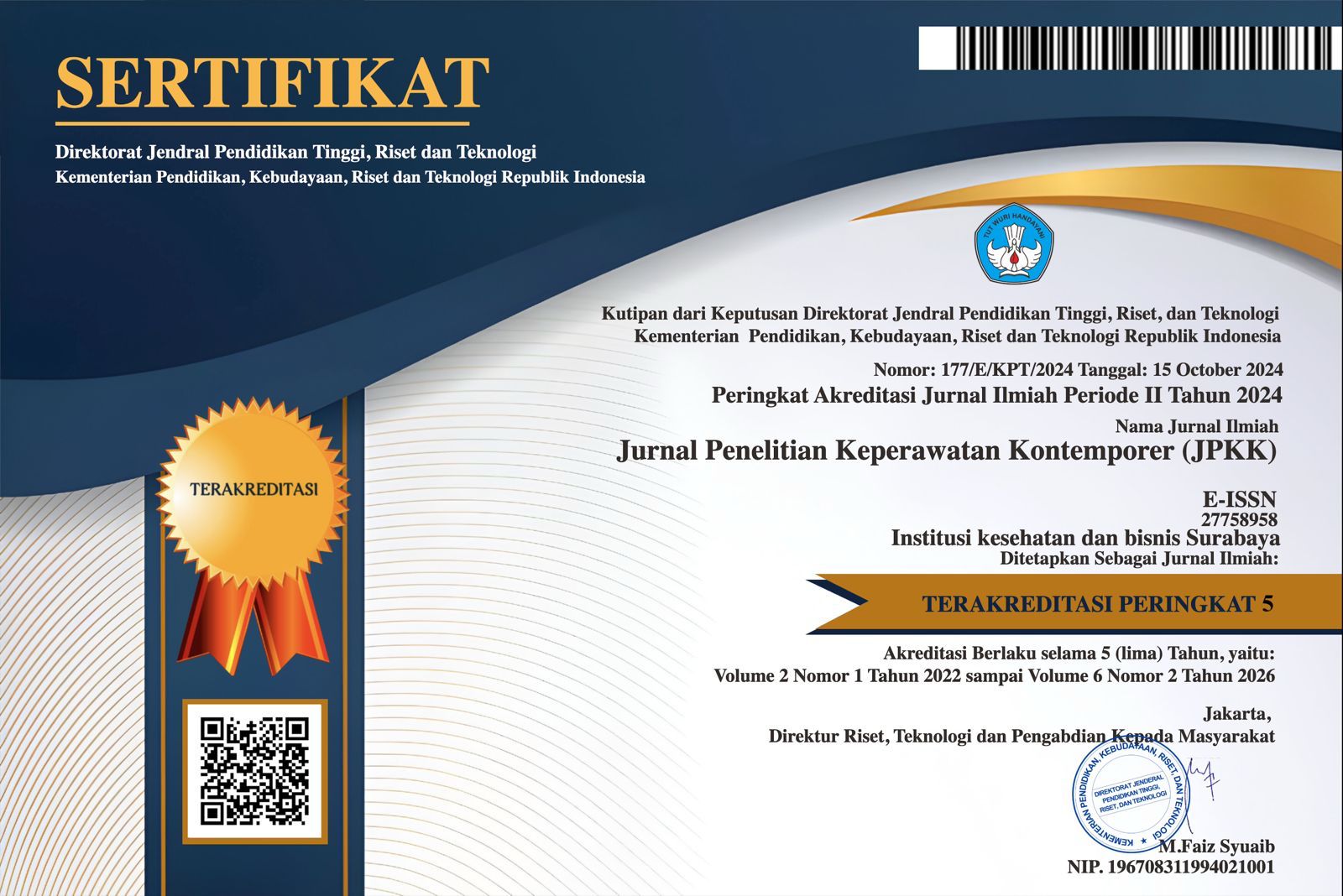KETERLIBATAN AYAH DALAM MEMBERIKAN PENDIDIKAN KESEHATAN REPRODUKSI DAN SEKSUAL PADA ANAK DI KECAMATAN PENGKADAN
DOI:
https://doi.org/10.59894/jpkk.v5i4.991Keywords:
Keterlibatan ayah, Pendidikan kesehatan reproduksi dan seksual, AnakAbstract
Latar Belakang: Kekerasan pada anak tengah marak terjadi diseluruh dunia, orang tua memiliki peran dalam memberikan informasi, arahan, dan pemahaman tentang kesehatan reproduksi dan seksual pada anak secara benar. Anak akan terbebas dari kekerasan seksual jika dilakukan pencegahan dengan memberikan pendidikan secara terus menerus dan berkeseinambungan. Tujuan: Mengetahui keterlibatan ayah dalam memberikan pendidikan kesehatan reproduksi dan seksual pada anak di Kecamatan Pengkadan. Metode: Penelitian mix method dengan pendekatan concurrent embedded stategy dilakukan dengan menyebarkan kuesioner dan wawancara terhadap 84 responden. Teknik pengambilan sampel kuantitatif menggunakan consecutive sampling dan sampel kualitatif menggunakan purposive sampling. Menggunakan kuesioner keterlibatan ayah dalam memberikan pendidikan pada anak yang sudah divalidasi dan panduan wawancara. Hasil: Keterlibatan ayah dalam memberikan pendidikan kesehatan reproduksi dan seksual mayoritas memiliki nilai pada kategori cukup yaitu sebanyak 71 (84,5%) orang dan kategori baik sebanyak 13 (15,5%) orang ayah. Bentuk keterlibatan ayah juga mencakup 4 dari 5 komponen keterlibatan ayah dalam pengasuhan anak yaitu positive activity engagement, warmth-responsiveness, control dan process responsibility. Kesimpulan: Mayoritas ayah sebagai responden memiliki keterlibatan cukup sehingga diharapkan untuk meningkatkan peran memberikan pendidikan kesehatan reproduksi dan seksual pada anak laki-laki maupun perempuan.
References
Baker, J. L., Lanier, Y., James, G., Fletcher, J., Delish, M., Opara, O., Sampson, C., Jemmott, L., & Stewart, J. (2018). “You Know What You Gotta Do”: African American Fathers and Sons Perspectives’ on Parent–Child Sexual Risk Communication and HIV Intervention Development Needs. Journal of Family Issues, 39(6), 1685–1711. https://doi.org/10.1177/0192513X17720960
Cameron, A., Smith, E., Mercer, N., & Sundstrom, B. (2020). ‘It is our duty:’ understanding parents’ perspectives on reproductive and sexual health education. Sex Education, 20(5), 535–551. https://doi.org/10.1080/14681811.2019.1704720
Dewiani, K., Purnama, Y., & Yusanti, L. (2019). Early Sex Education and Children ’ S Reproductive Health for. Dharma Raflesia Unib, 2, 1–6.
ECPAT. (2016). Terminology Guidlines for the Protection of Children from Sexual Exploitation and Sexual Abuse (E. International (ed.)). ECPAT Luxembourg.
Faludi, C., & Rada, C. (2019). Gender differences in sexual and reproductive health education in the family: a mixed methods study on Romanian young people. BMC Public Health, 19(1), 1103. https://doi.org/10.1186/s12889-019-7321-0
Fantaye, A. W., Buh, A. W., Idriss-Wheeler, D., Fournier, K., & Yaya, S. (2020). Effective educational interventions for the promotion of sexual and reproductive health and rights for school-age children in low- And middle-income countries: A systematic review protocol. Systematic Reviews, 9(1), 1–8. https://doi.org/10.1186/s13643-020-01464-w
Hutchinson, M. K., & Cederbaum, J. A. (2014). Talking to daddy’s little girl about sex: Daughters’ reports of sexual communication and support from fathers. Journal of Family Issues, 32(4), 550–572. https://doi.org/10.1177/0192513X10384222
Kee-Jiar, Y., & Shih-Hui, L. (2020). A systematic review of parental attitude and preferences towards implementation of sexuality education. International Journal of Evaluation and Research in Education, 9(4), 971–978. https://doi.org/10.11591/ijere.v9i4.20877
KEMENKES, R. (2017). Infodatin Reproduksi Remaja. In Situasi Kesehatan Reproduksi Remaja (pp. 2442–7659). KEMENTRIAN KESEHATAN REPUBLIK INDONESIA PUSAT DATA DAN INFORMASI.
Koren, A. (2019). Reproductive Health for Teens: Parents Want In Too. Journal of Sex and Marital Therapy, 45(5), 406–413. https://doi.org/10.1080/0092623X.2018.1549635
Lamb, M. E. (2010). The Role of the Father in Child Development. In I. John Wiley & Sons (Ed.), The Role of the Father in Child Development (Fifth edit). New Jersey. https://doi.org/10.1097/00004583-198311000-00012
Lesch, E., & Brooks, S. (2019). Man Talk: Exploring Sexual Communication Between Fathers and Sons in a Minority South African Community. Sex Roles, 81(3–4), 173–191. https://doi.org/10.1007/s11199-018-0988-3
Maryatun, & Purwaningsih, W. (2012). Hubungan pengetahuan dan peran keluarga dengan perilaku seks pranikah pada remaja anak jalanan di Kota Surakarta. Gaster, 9(1), 22–29.
Novrinda, Kurniah, N., & Yulidesni. (2017). Peran Orangtua Dalam Pendidikan Anak Usia Dini Ditinjau Dari Latar Belakang Pendidikan. J u r n a l P o t e n s i A, 2(1).
Nursyamsi, & Yanti, N. (2019). Peranan Ayah dalam Pendidikan Anak. Mau’izhah, IX(2), 91–106.
Orji, C. J., Arinze-onyia, S. U., & Obionu, C. N. (2019). Parental Verbal Communication and Sexual Knowledge of Senior Secondary Students in South. Ethiop J Health Sci, 29(4).
Panjalipour, S., Khalesi, Z. B., Rezaie-Chamani, S., & Kazemnejad, E. (2020). Female adolescent health needs and determinants. Jornal Brasileiro de Reproducao Assistida, 24(2), 158–162. https://doi.org/10.5935/1518-0557.20200011
Partasari, W. D., Rosa, F., Lentari, M., Ganjar, M. A., & Kunci, K. (2017). Gambaran Keterlibatan Ayah dalam pengasuhan Anak Usia Remaja ( Usia 16-21 Tahun ) Descriptive Study about Father Involvement from Father with Adolescent Children ( age 16-21 ). Jurnal Psikogenesis, 5(2), 159–167.
Pleck, J. H. (2014). Paternal involvement: Revised conceptualization and theoretical linkages with child outcomes. The Role of the Father in Child Development, Fifth Edit(Editor Michael E. Lamb), 58–93.
Randolph, S. D., Coakley, T., Shears, J., & Thorpe, R. J. (2017). African-American fathers’ perspectives on facilitators and barriers to father—son sexual health communication. Research in Nursing and Health, 40(3), 229–236. https://doi.org/10.1002/nur.21789
Suteja, J., & Riyadi, M. (2019). Revitalisasi Peran Orang Tua Dan Guru Dalam Memberikan Pendidikan Seks Pada Anak. Equalita, 1(1).
UNICEF. (2020). Global status report on preventing violence against children 2020.
WHO. (2017). Sexual and Reproductive Health Universal. In World Health Organization Regional Office for Europe (Issue 2, pp. 1–8). http://www.euro.who.int/__data/assets/pdf_file/0005/348008/Fact-sheet-SDG-SRH-FINAL-04-09-2017.pdf?ua=1
WHO. (2018). WHO recommendations on adolescent sexual and reproductive health and rights (WHO (ed.)). WHO. https://apps.who.int/iris/bitstream/handle/10665/275374/9789241514606-eng.pdf?ua=1
WHO, UNICEF, UNAIDS, UNFPA, & UNWOMEN. (2018). International technical guidance on sexuality education. In United Nations Educational Scientific and Cultural Organization SDGs (pp. 1–139). United Nations Educational, Scientific and Cultural Organization (UNESCO). http://unesdoc.unesco.org/images/0026/002607/260770e.pdf
Wilson, E. K., & Koo, H. P. (2010). Mothers , fathers , sons , and daughters : gender differences in factors associated with parent-child communication about sexual topics. Reproductive Health, 7(31), 1–9.
World Health Organization, W. (2020). Addressing Violence Against Children , Women And Older People During The Covid-19 Pandemic : Key Actions (Issue June). World Health Organization.
Downloads
Published
How to Cite
Issue
Section
License
Copyright (c) 2025 Desi Asih Purwanti, Eka Riana

This work is licensed under a Creative Commons Attribution 4.0 International License.
All articles published by Jurnal Penelitian Keperawatan Kontemporer (JPKK), the authors hold the copyright under license Creative Commons Attribution License.











